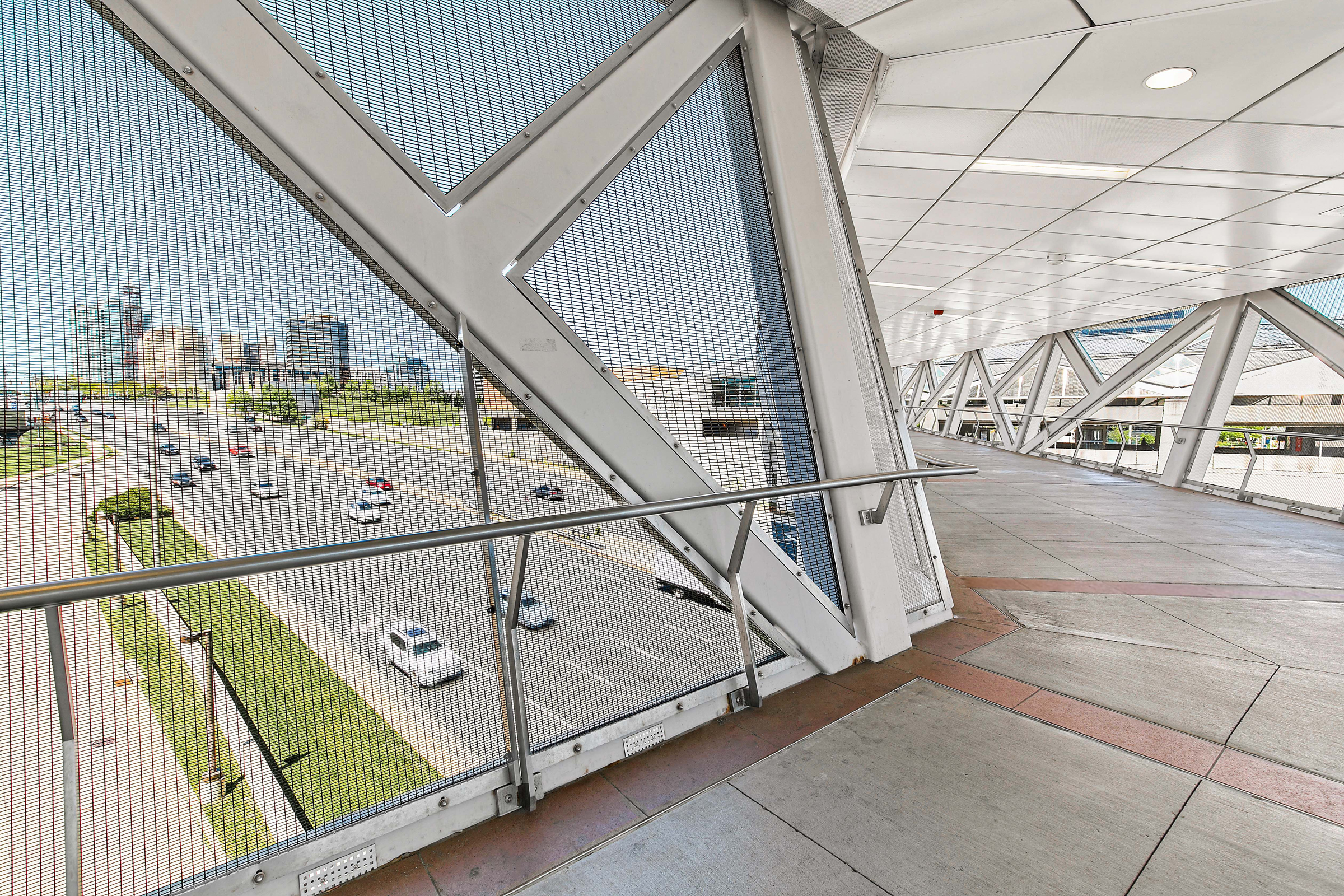Story at a glance:
- A closer look at high-performing exteriors, intricate details, durability, and more
- GKD Metal Fabrics provide expert, custom architectural wire mesh solutions for inside and out—from elaborate facades to railing infills to parking garage exteriors.
- Architects like those at SOM turn to metal panels or other metal details on countless projects.
The way we use metal has evolved tremendously over the years. GKD Metal Fabrics was founded more than 25 years ago in Maryland. As a subsidiary of GKD in Düren, Germany, founded in 1915, GKD-USA has been one of the leading North American experts in weaving metal fabrics. Architects are increasingly seeking out architectural metal for everything from facades to interior details.
“Pretty much every project we do is a custom project,” says Tom Bialk, vice president of engineering at GKD, USA. Bialk has been there for more than 16 years, and he’s watched as interest in the industry has evolved.
GKD does everything from metal fabrics for railing infill and decorative cabinetry pieces to more elaborate custom designs like the bronze mesh used at the Ben Bridge Jewelry Store in Seattle, designed by RGLA Architects. They also provide significant weight and safety testing for things like infill on railings at behavioral health centers, while spending much of their time customizing innovative pieces for everything from parking garages to arenas.
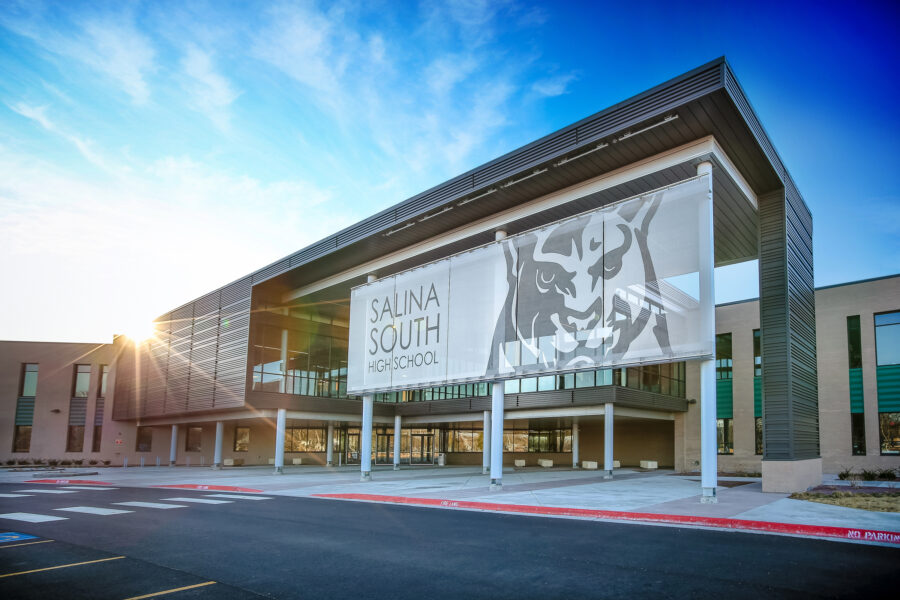
Salina South High School in Kansas was designed by DLR Group and includes transparent signage that allows the school to showcase its brand without closing off the courtyard on the outside. The innovation solution was engineered by GKD Metal Fabrics. Photo courtesy of GKD Metal Fabrics
The company’s extensive color and texture capability brings them a lot of facade business. Their solutions can also help building shells become energy-efficient solar protection systems that adjust for different times of the day, while bright LED media facades can display high resolution content. On the interior side, sound-absorbing ceiling systems using metal fabrics can improve room acoustics, while semi-transparent room dividers help structure interior designs.
“Our materials roll up like carpet, so we can weave up to 30-foot-wide panels, with unlimited length. Whether you’re designing a parking garage or a facade, we can cover a large area at one time with minimal substructure behind it,” Bialk says.
He says parking garages are a big market for GKD because architects are often faced with tackling how to make them more attractive. “You’ve got to figure out how to make it look pretty. We can add graphics, and we can paint the stainless steel with logos.”
These metal fabric solutions aren’t just aesthetically pleasing; they also have benefits like sunshading on glass curtain walls, durability in storms with solutions that can handle heavy wind loads, and security in health care settings. GKD fully engineers all of its systems in-house, designing and fabricating essentially everything from their North American headquarters. They also launched a new binding perimeter in June.
Interior Designs
Inside buildings, GKD has seen an increased demand in ceiling projects for acoustic as well as aesthetic purposes, and they can provide solutions with an NRC value of .9, or 90% sound absorption. Their innovations in SilentMesh are also popular. This mounting system uses a hidden clip for open, accessible ceilings that attaches to the metal fabric panel and then to the framework above the mesh for a clean appearance and secure installation. “There are some very good sound absorption qualities to that,” Bialk says. “We can do a lot of different patterns, we can do bronze, stainless, and aluminum, and all kinds of different colors for interiors as well.”
The GKD applications and engineering teams are working on new and challenging applications every day. Architects bring them questions, and GKD engineers the answers, Bialk says. “We work to come up with the best solution at the best cost with the best aesthetics.”
For a behavioral health facility at the University of Washington, GKD designed strong infill that allows patients fresh air and daylight while being safe and secure—durable and with no sharp edges. “The frames are seamless, and the panels were engineered to withstand an average person’s weight for patient protection.”
Near Dulles International Airport, GKD worked on five commuter train stations, engineering metal for both safety and aesthetics along the walkway. They’ve also done work for the Miami Heat basketball arena. There, a large Mediamesh installation transformed downtown Miami into a dynamic display of light and graphics while allowing for natural light and ventilation. Mediamesh incorporates graphics into metal fabrics with LEDs for a controllable, illuminated solution. It can display digital imagery, logos, advertising, film, and video through a web-based interface. Mediamesh fabric is flexible in the length direction so it can be easily rolled for transport.
Why Architects Use Metal Details
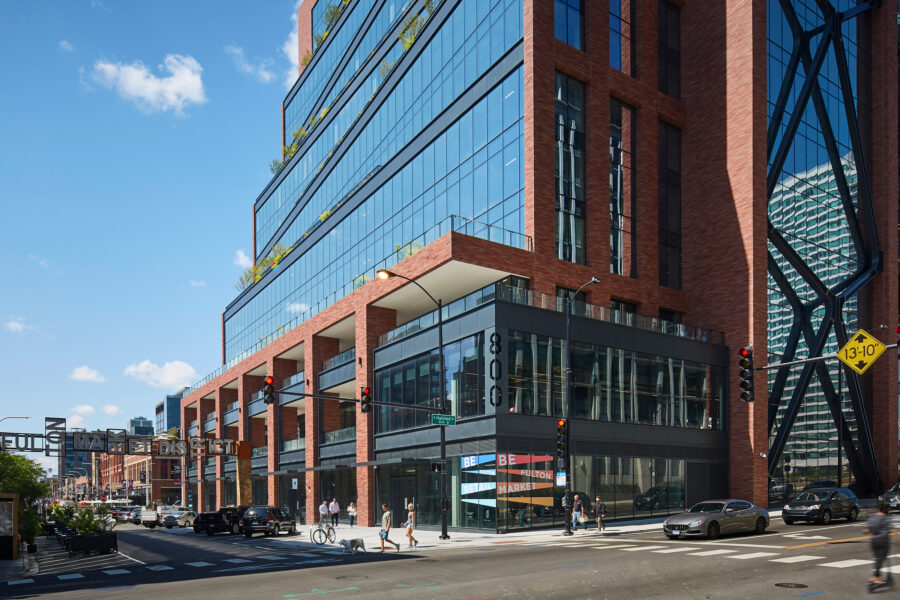
SOM has a strong legacy of structurally expressive architecture, as seen at 800 Fulton Market with its X-braced facade. External steel brace frames on the east and west elevations were engineered with Chicago’s harsh winters in mind. Photo by Dave Burk
Skidmore, Owings, & Merrill (SOM) uses metal in a myriad of ways, inside and out, across projects.
“We use architectural metal, things like aluminum panels, on virtually every project,” says Kevin Rodenkirch, associate principal at SOM. “It’s super flexible. Whether it’s the trim work, the edging, or even copings or roof structures, it shows up a lot.”
SOM used metal inside and out at 800 Fulton Market, a mixed use project in an increasingly design-centric neighborhood of Chicago—from an innovative metal brace on the exterior to details in the entry retail space and building lobby. “To me the metalwork is what kind of makes it special,” Rodenkirch says.
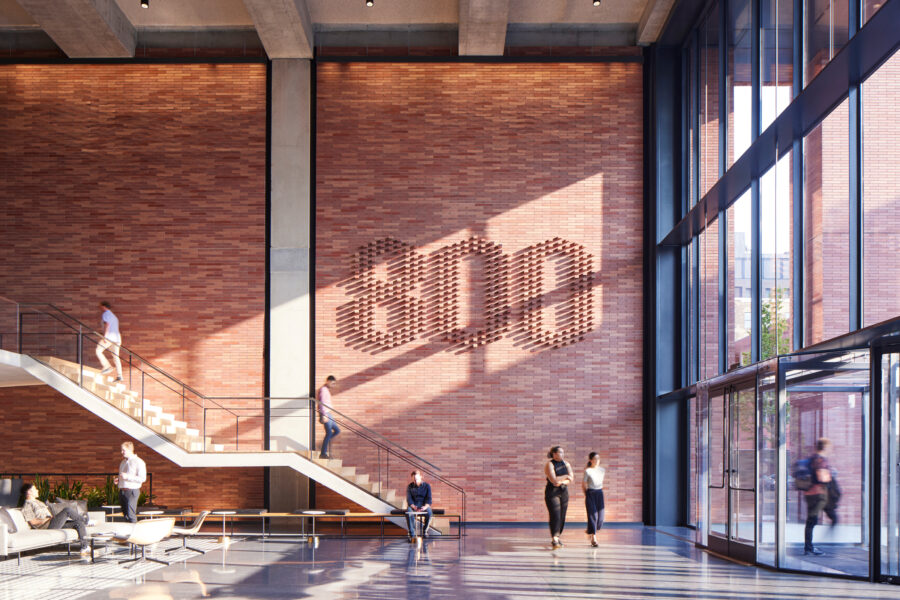
Inside 800 Fulton Market, designed by SOM. Photo by Dave Burk
He says architects frequently turn to metal because it helps the design transition from something like a door to a brick wall. “You need to open it up, especially in retail, when you’re trying to create an entry. You want it to feel very welcoming and warm. A lot of the metal work gives depth and texture.”
Often SOM uses metal for intricate details, too, or to provide balance against interior glass walls. “Maybe you don’t want just an aluminum box every five feet; you can do these custom metal shapes,” Rodenkirch says.
Sustainability and More
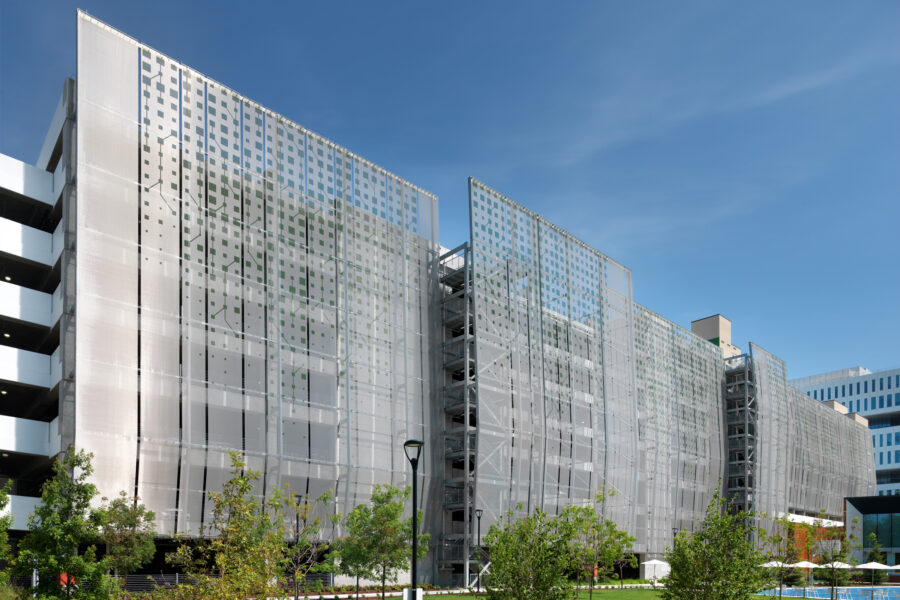
GKD provided an innovative parking garage facade solution for Samsung. Photo courtesy of GKD Metal Fabrics
GKD’s mesh is stainless steel and fully recyclable, as well as being made from up to 70% recycled content to start with, Bialk says. Its use for sunshading helps to reduce the amount of air conditioning in buildings, too. Their solutions are very resilient to corrosion and are designed to withstand heavy loads, with significant testing in R&D. That’s important in a world of increased storms, Bialk says. Their metal is designed to withstand everything from heavy winds to impact. “Even when we do interior projects, we put a five pound per square foot HVAC load on,” he says.
GKD has weaving capabilities that happen all over the world, including at GKD’s Maryland facility. “It’s kind of amazing. When I came in more than 15 years ago I didn’t know you could weave metal together. I thought it was welded together, but it’s woven just like textiles are for clothes. It’s interesting to see.”
Bialk says architects appreciate GKD because it’s a one-stop shop for ideation, fabrication, and install. “They don’t have to pay five different contractors to do five different things. That’s what makes us unique in the market. People come to us with problems, and we design the solutions.”

